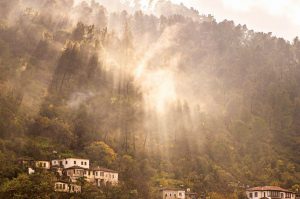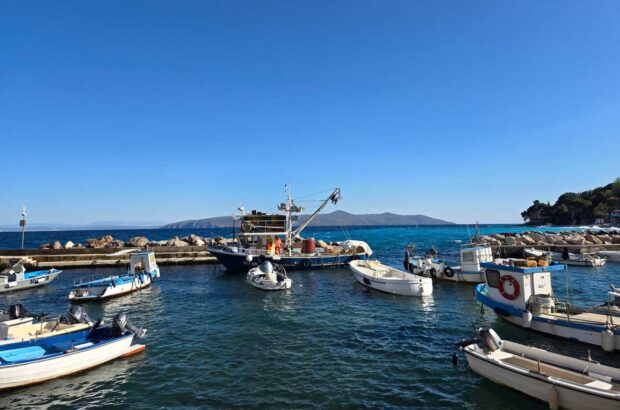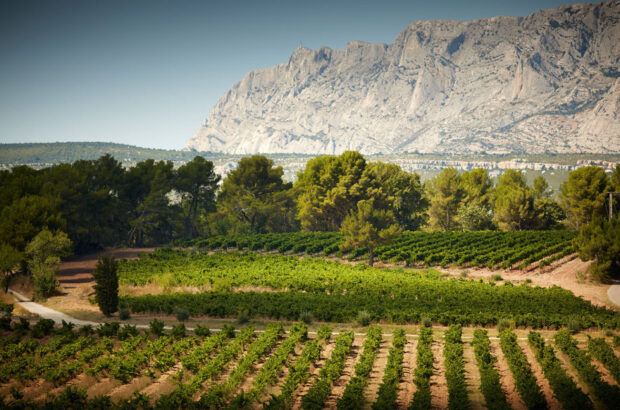In partnership with Wine Vision by Open Balkan
With its roster of impressive indigenous grape varieties, a steady increase in vineyard plantings throughout many of its fabulous terroir-rich regions and a growing number of highly talented, quality-focused winemakers, Albania is finally beginning to be recognised as an important – and distinctive – Balkan wine country.
Most other countries in the region have been enjoying a remarkable wine renaissance for several years already. But Albania, even with an ancient viticultural history similar to its neighbours – this dates back at least to the 8th century BC, when the Illyrians inhabited the Balkan peninsula – experienced enormous challenges during the second half of the 20th century.
At that time, under Albania’s highly repressive communist government, grape-growers were forced to hand over their harvests to state-owned factories which, in turn, produced massive quantities of low-quality wine. After the country’s political system collapsed and the free market economy was introduced in the early 1990s, thousands of its vineyards were abandoned, or even destroyed or converted for other agricultural purposes by new, private landowners with bitter memories of the old regime. Moreover, where grapes were still appreciated, they were used more for producing raki, the nation’s popular distillate (similar to Italy’s grappa).
Scroll down for Darrel Joseph’s 10 Albanian wines to try
The world’s growing fascination with wine and the flourishing wine industry in neighbouring Balkan countries have helped spawn Albania’s wine revival, leading to better-than-ever quality today. While forward-thinking oenologists and growers are a significant and increasingly widely travelled part of this, the absolute basis for Albania’s wine excellence today is, of course, provided by nature.
Ideal conditions
The country’s western coastline is washed by the Adriatic and Ionian seas, and its northern, eastern and southern borders meet neighbouring nations including North Macedonia and Greece (to the south), meaning that Albanian vineyards thrive under a beautiful combination of Mediterranean and continental climatic conditions. Warm sea breezes, foggy mornings, roasting-hot sunny days, very cool nights, summer rains, brisk mountain winds – they’re all here.
Tirana: A wine and food lover’s guide
So are the ideal soils, ranging from sand, loess and clay to alluvial and limestone. And what’s planted in them, at altitudes from 150m-1,000m, are Albania’s treasure trove of grape varieties, especially the indigenous and regional ones including Shesh i Zi (Black Shesh), Shesh i Bardhë (White Shesh), Kallmet (known as Kadarka in other countries), Debinë e Bardhë, Pulës (or Puls; Pulsi), Serina, Vlosh and Vranac.
According to the Centre of Transfer of Agricultural Technology, a research institute in Albania’s southern Vlorë wine district, of the 107 known indigenous and regional grape varieties in Albania, 57 are growing in the country’s vineyards, with Shesh i Zi and Shesh i Bardhë the most planted by far. Cabernet Sauvignon, Merlot and Riesling lead the roster of 83 international grapes planted.

Kantina Duka’s coastal vineyards in the Central region, north of Durrës, with the Adriatic sea just 2.5km in the distance. Credit: Dashamir Elezi
Outward-looking
Wine production from Albania’s three main wine regions, North, Central and South, totals 2.6 million litres (65% bottled, 35% bulk), according to the latest figures from the country’s Ministry of Agriculture & Rural Development. About 80% of this is consumed at home, with the remaining 20% exported, largely to markets such as Montenegro, Switzerland and Germany.
However, figures for vineyard plantings – which the Center of Transfer in Vlorë now puts at 8,400ha – are set to change some time this year. The same is true for registered quality wineries – presently 76 (49 with brand labels). As Albania is now in accession negotiations with the European Union, a new national wine law that aligns with EU regulations has recently been passed, so thorough tallies must be carried out for accuracy.
‘The law passed in parliament earlier this year gives the go-ahead for the clear establishment of wine appellations with PDO [Protected Designation of Origin] and PGI [Protected Geographical Indication],’ says Dashamir Elezi, president of the Albanian Sommeliers Association and a major proponent of Albania’s new quality wine system. ‘The regulations will be strict.’
Adds Taulant Balla, Majority Group Leader in the Parliament of the Republic of Albania: ‘The EU standards create opportunities for production to develop further, and even to help avoid problems for our wines entering these other markets. We are very much on the right path.’
Central region
At the forefront of this movement, the Central region is home to the majority of Albania’s most widely planted – and showcased – wine grapes, white Shesh i Bardhë and red Shesh i Zi. Just over 4,000ha of these are planted in the Kavajë and Durrës districts, whose western borders meet the Adriatic sea.
Kantina Belba (‘kantina’ means winery) in the city of Kavajë, 40km southwest of the Albanian capital Tirana, is one of the leading Shesh producers. Its Shesh wines, nurtured in its sustainably managed Golemas vineyard site – complete with surrounding pomegranate and olive trees, and grasshoppers jumping among wild thyme and oregano shrubs – reflect a true Mediterranean sense of place. The gentle climate, 250 days of sunshine annually and, especially, the winds from the Adriatic, help keep the grapes clean and disease-resistant. Winery owner Fatbardh Belba refers to Shesh i Zi as ‘the most beautiful grape in the world’, ageing it mainly in used barriques (see box, below).
In contrast to Belba’s modern winery and winemaking approach is the time-capsule Librazhd winery on the other side of the Central region, in the Librazhd district. Founded by the state communist government in 1960 but now privately owned, Librazhd retains its original structure and, yes, much of its original equipment. The Shesh i Zi here can have an easy-drinking expression.
Other quality Central region wineries producing Shesh include: Bardha, Bello, Duka, Kokomani and Skënderbeu

The UNESCO heritage site of Berat, home to several native Albanian grapes. Credit: Mark de Jong
South region
Berat, a UNESCO World Heritage Site city (pictured above) as well as a wine district, is where a number of centuries-old indigenous varieties thrive. These include the white Pulës and Debinë e Bardhë (or Debina e Bardhë), as well as the red Serina and Debinë e Zezë.
During Albania’s nearly five centuries under Ottoman rule, which ended in 1912, Pulës and Serina were often planted next to oak trees so that the vines could grow up the tree trunks. Numerous reasons for this are claimed, but healthy vine maintenance seems to be the most practical one: the avoidance of morning fog exposure, and natural insect control by hungry nesting birds.
Today, wineries such as Kantina Nurellari grow these varieties in vineyards with the Guyot-training system. Nurellari vinifies Serina either as a fresh and fruity rosé, or as a premium, full-bodied red wine from grapes which are dried for several weeks before barrique ageing for a year. The Pulës – or Pulsi here, where it is noted for its vibrant acidity – is equally versatile, vinified dry and matured in stainless steel, or lusciously sweet and aged in barrel.
In brief: Albania’s grapes
The most widely planted grapes in Albania are Shesh i Zi (Black Shesh), with 2,720ha, and Shesh i Bardhë (White Shesh), with 1,352ha. This represents nearly half of all wine grape plantings in the country. Besides Merlot (735ha), all other varieties, whether indigenous or international, are planted to no more than 200ha each.
Shesh i Zi (pronounced ‘shesh-ee-zee’). Albania’s flagship red grape. First documented 700 years ago, this late-ripening, high-yield variety makes medium-bodied, fruit-forward wines. With yield control and some barrel ageing, it can be full and mouthfilling with currant, cherry and blackberry flavours. A fine food partner.
Shesh i Bardhë (pronounced ‘shesh-ee-bard-uh’). A mutation of Shesh i Zi, this white variety delivers ripe white fruit flavours, such as peach and pear, and can have herbaceous undertones. The acidity can be pronounced unless harvested on the exact point of ripeness. Serina Found in red and white versions, though the red (Serina e Zezë) is most prominent. Can be like Syrah. Fewer than 200ha.
Pulës or Puls, Pulsi. White, fewer than 200ha.
Kallmet (also Kardarka) Red, 111ha. Debinë e Bardhë White, 71ha.
Vlosh Gentle red, 33ha.
South of Berat, in the Tepelenë wine district, Kantina Zika produces Serina as well – it grows not far from the Vjosa river, one of Europe’s last living wild rivers – but utilises it as a blending variety with Cabernet Sauvignon and Merlot in its Derveni N.1.
In the Korcë district to the country’s southeast, Kantina Korça 2000 winemaker Elisabeta Lëmi – one of Albania’s few female oenologists – and her son Menelaos produce wines from Serina, Mavrud (also widely grown in Bulgaria) and Debinë e Bardhë. The grapes for the latter – a stunning wine – are sourced from vineyards nearly 900m high, featuring limestone, marble and granite soils. Despite roasting daytime heat, which in the summer is often above 40°C, cool evening temperatures preserve Debinë’s characteristic fresh acidity.

A pergola Veronese trellis system at Kantina Enofama. Credit: Darrel Joseph
In the Fier wine district, not far from the Adriatic coast, a new winery, Kantina Arianiti, is concentrating on Shesh i Bardhë and Shesh i Zi, along with Cabernet Sauvignon, Merlot and Sangiovese. Nymphaion 2020, the winery’s highly anticipated premium wine, is a blend of Cabernet Sauvignon, Merlot and Shesh i Zi that’s aged in French barriques – its initial release was scheduled for early October 2023.
Other wineries to look out for in Albania’s South region: Bejko, Çobo (producing a traditional-method sparkling wine, Shendeverë, from Pulës grapes), Enofama (with a lovely Vranac), Caco and Max Mavrud
North region
Hugging the Adriatic coast, the Lezhë district in the North region is home to the Kallmet grape. Also known as Kadarka in Hungary and Gamza in Bulgaria, this sensitive, thin-skinned red variety is susceptible to fungal infection, so Lezhë’s dry climate, vine-cleansing winds and alluvial soils prove ideal for nurturing healthy grapes.
Kantina Kallmeti, located in the village of Kallmet, produces three versions of the variety: a ‘classic’ style with some barrel age; a barrique-aged Prestigj (see tasting notes, below) and an amarone-style Privilegj from dried grapes. Kallmet is also grown in the Shkodër and Malësi e Madhe districts.
Other quality producers include: Arbëri, Mrizi i Zanave, Medaur and Uka

Kantina Belba’s Kavalion vineyard in the village of Golemas, Kavajë district. Credit: Dashamir Elezi
While the wineries, grape varieties and terroirs mentioned here represent just a glimpse of the Albanian wine landscape today, it is clear that this is a country at the beginning of a new journey – including letting the world outside its borders know that Albania even exists as a wine-producing nation!
Fortunately, the drive and passion of Albania’s new winemaking generation are in sync with the rising international reputation of Balkan wines overall. And the fact that Albania is already aligning its wine quality standards to those of the EU will help to ensure that an even more exciting future lies ahead; a future in which Albanian wines are not only a key part of the Balkan wine constellation, but also a compelling country option for curious palates around the world.
Joseph’s pick: 10 wines defining the future for Albania
Korça 2000, Karnavalet Debina e Bardhë, Korcë 2022
From vines planted in the late 1960s, this wine shows a fresh, tight yet elegant structure with a mineral undertone. There are fragrant aromas of light acacia and citrus blossom with a bit of passion fruit and kumquat. Gentle acidity supports the fine fruit flavours that include passion fruit, lemon, lime, guava, mandarin, even yellow peach. A light oily texture adds a tropical accent.
Drink 2023-2026 | Alcohol 12.8%

Balaj, Plithure Trevllazer, Vlorë 2021
This natural wine from 100% Shesh i Bardhë grapes spent three weeks on its skins, ultimately delivering exotic aromas of gunpowder, dried orange peel, bay leaf and light coffee bean with a hint of suede. Green tea and firm, gripping tannins coat the lively palate supported by a beautiful structure and elegant astringency. Dried apricot and light apple fruit on the finish. Delicious.
Drink 2023-2027 | Alcohol 13.5%

Belba, Papaz, Golemas, Kavajë 2017
Named after a tiny bubbling mud pool near the vineyard, the Papaz weds an obscure Albanian grape, Kabjuro, with classic Bordeaux varieties. The elegant nose wafts with violets, cinnamon, blackcurrant leaf, blackberry fruit and toasted oak, while the juicy, structured palate delivers a lengthy mouthful of ripe blackberry and plum flavours, vibrant acidity and still youthful tannins.
Drink 2023-2035 | Alcohol 15%
Nurellari, Premium Serina, Berat 2019
Made using the revived Serina variety, this is a sophisticated wine from grapes dried for nearly four weeks, aged in American oak. Fresh black cherry and blackberry-vanilla aromas, and a lush palate with notes of ripe cherry and boysenberry, hints of tobacco and spice. It has fabulous structure with lovely acidity, mouthfilling fruit, ripe tannins and finely integrated alcohol. A real discovery.
Drink 2023-2032 | Alcohol 15.5%

Duka, Reserva Superiore, Durrës 2020
From vineyards just 1km from the Adriatic, this luscious blend of Cabernet Sauvignon, Merlot and Tempranillo reflects the salty terroir that nurtured it. Gorgeous structure and concentration, with wonderful fruit and oak integration. Scents of lilac, violets and wisteria are joined by flavours of blackberry and cassis. Seductive on all fronts. Real personality!
Drink 2023-2033 | Alcohol 14.5%
Kallmeti, Kallmet Prestigj, Kallmet, Lezhë 2020
A fine Kallmet that has aromas of bay leaf and light coriander, and a slight hint of vanilla from the Hungarian oak. The palate opens gradually to red fruit notes – redcurrant, raspberry, cherry – then complexity kicks in with a potpourri of herbs, spices and light cedar. A very layered structure, with fresh acidity and barrel age finely integrated. Beautiful varietal interpretation.
Drink 2023-2029 | Alcohol 14%

Kallmeti, Privilegj, Kallmet, Lezhë 2020
An amarone-style wine made from Kallmet grapes dried on racks for five weeks. Aged in Hungarian barriques, this complex wine shows intense body and flavours of black liquorice, blackberry and mulberry, with undertones of blackcurrant, lingonberry and black cherry, with herb and spice tones, too. The generous acidity is well suited to the powerful alcohol.
Drink 2023-2030 | Alcohol 17%

Zika, Derveni N.1, Tepelenë 2015
This stylish blend of Merlot (55%), Cabernet Sauvignon (25%) and Serina e Zezë (20%) delivers a delicious interplay between fruitiness and savouriness. Plenty of ripe blackberry, blackcurrant, plum and blueberry tones coddled by bay leaf and a fine, saline undertow. The Serina is the magic ingredient, delivering fruit sweetness and tempering the tannin structure. A unique blend, firm with integrated acidity and fine length.
Drink 2023-2029 | Alcohol 14.5%
Belba, Kavaljon, Golemas, Kavajë 2018
This Shesh i Zi red was soaked on the skins for 20 days before its oak ageing. The nose wafts with red and dark fruit scents of redcurrant, plum and blackberry, and a light whiff of oak. The palate exudes redcurrant, chewy cherry and blackberry, confidently supported by a touch of cedar spice. Mouthfilling with juicy acidity and zesty-fresh tannins, and a nice mineral undertow.
Drink 2023-2028 | Alcohol 14.5%

Nurellari, Verëe Shenjtë, Berat 2016
An intriguing 100% Pulës dessert wine with aromas of kumquat, star fruit, maracuja (yellow passion fruit), pear and mandarin. On the palate are seductively discreet expressions of baked apple, peach compote, yellow peach, ripe pear and acacia. The elegant sweetness, vibrant acidity and confident alcohol reflect a cool yet forward sophistication that continues in a fine, lengthy finish.
Drink 2023-2035 | Alcohol 15%
Discover more about Wine Vision by Open Balkan
Connect on
Facebook | Instagram
Read more about the wines of the Balkans
North Macedonia: A wine nation at the crossroads
Serbia: An ancient wine country reinventing itself for modern tastes









